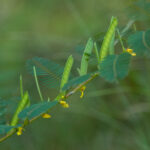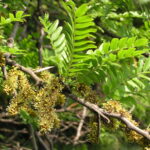By Uriah St. John, Seasonal Naturalist

Photo by Janet Tarbox
While there are many different families of plants in Ohio, one of the most interesting to me is the family Fabaceae, often called the legume family. I find this family so fascinating, because you can find so many different forms of it in Ohio. From honey locust trees to partridge peas, and even non-native soybeans in our farm fields, Fabaceae can be found all around us in many different forms. Ohio has five native species of Fabaceae: honey locust, Kentucky coffee-trees, eastern redbud, senna, and partridge pea. Three trees and two herbs; not things you usually think of as being closely related. However, there are a few key traits that they each share: flowers, legumes, and nitrogen fixing bacteria.

Photo by Andrew Butco
While flowers are often taken for granted on plants, they are there on all Fabaceae species. Many people are aware of, and even plant them for the flowers of partridge pea and senna which bloom in late summer, and of course the flowers of the redbud in spring. However, Kentucky coffee-trees and honey locusts have flowers too! Like many other trees their flowers are greenish white, and often overlooked. However, without their flowers these angiosperms would not be able to reproduce and create the legumes they are famous for.
While their legumes are something all these plants share, it is also another feature which shows off the great diversity of this family. With partridge peas producing pods rather large for its size, to the redbud which produces similarly sized pods on its branches, to the honey locust and coffee-tree which produce pods larger than your hand. The pods are also many shapes: rectangular, flat bean shapes, and spirals. Additionally, only some of the pods are edible, with the Kentucky coffee-tree seeds being poisonous to humans and most wildlife.
The last shared feature I will highlight is the presence of bacteria in their roots. For a reason that is still unknown plants in the family Fabaceae require a lot of nitrogen. To meet this need they have a special relationship with bacteria. Most legumes have bacteria that live in their roots and pull nitrogen out of the atmosphere for them. Thereby helping to fulfill the plants’ craving. In return the plants provide special nodes in their roots for the bacteria to live along with all the nutrients the bacteria need. This symbiotic relationship is why legumes sometimes increase soil nitrogen content for other plants as well.
I find the Fabaceae family amazing, because of how diverse of a family it is. It amazes me that nature can produce a single family with everything from prairie flowers to woody trees with spiked trunks. That’s one thing I love about the natural world. If you take the time to look for them, you can find similarities in things you never would’ve dreamed are related. Venture out onto thee trails in the parks and see what members of the Fabaceae you can find this summer and fall.
PPDC Note: This will be Uriah St. John’s last blog post for us. He has accepted a full-time position with Metroparks of Butler County in southwestern Ohio. We would like to thank Uriah for his help over the last two summers and wish him much success in his new role.







